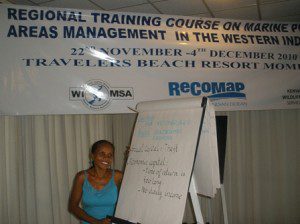By Lalao Aigrette, Coastal resources Manager. From the 22nd of November to the 4th of December 2010, I attended a regional training course on Marine Protected Areas management in Western Indian Ocean (WIO) held in Mombasa, Kenya. The training was organised by the Western Indian Ocean Marine Science Association (WIOMSA).
The training aims to build capacity for Marine Protected Area (MPA) staff who undertake management, supervisory and administrative roles within MPAs in the WIO and to complete level II of the Western Indian Ocean Certification of Marine Protected Area Professionals (WIO-COMPAS) certification process.
Twenty-four participants in total from different MPAs within the WIO came from places such as: Seychelles, Madagascar, Mauritius, Comoros, South Africa, Mozambique, Tanzania and Kenya to attend this training.
All the modules provided by the training were of great use to me as I continue my career as an MPA manager. In particular, a workshop on participatory processes and communications has enhanced my ability to successfully communicate this information and improve the overall communications strategy that Blue Ventures will use in the creation of a locally managed marine area (LMMA) network.
From this training, I have learnt from fellow MPA managers about the methodologies they use for monitoring and evaluation, as well as how they have been able to effectively integrate the results of their monitoring into adapting management strategies.
This training also gave me an opportunity to share my experiences of the LMMAs and their management in southwest Madagascar with other MPA practitioners, and build upon what others have already learnt and accomplished. The knowledge and skills that I have acquired from the training will allow me to continue to apply and develop best practices for the management of marine and coastal resources.
As one of the main outcomes of this training, and in order to develop the sustainable management of MPAs in WIO region, the participants decided to create an MPA managers network.
During my time in Mombasa, we were also able to explore the Mombasa Marine National Park; and it was my first time diving in an MPA other than where I work. Mombasa Marine National Park is characterised by a high percentage of soft coral, lots of fish and many other species. The National Marine Park is managed by Kenya Wildlife Service (KWS), which is an organisation mandated by government to manage the protected areas in Kenya. KWS is working with the Beach Management Unit (BMU) which is a community of fishermen, to manage the MPA.
We also visited Tsavo, a terrestrial National Park located about 100 km from Mombasa city. This Safari gave me a chance to see Kenya’s ‘Big Five’ (Giraffe, Buffalo, Elephant, Lion and Gazelle) which I have never seen in my country. Tsavo National Park covers an area of 13747 km2 and is home to many animals.
As part of this trip, I also went to visit the Kwetu training centre, located in few miles north of Mombasa. Kwetu trains unemployed youths, women and artisanal fishermen for self-employment by making use of available natural resources and appropriate technology in order to alleviate poverty. Kwetu has three key departments: organic farming and bee keeping, mariculture, and Neem processing. This is a great example of alternative ways to generate income which could be developed further with the MPA’s neighbouring communities.
Thanks to WIOMSA, Regional Coastal Management Programme of the Indian Ocean Countries (Recomap) and the KWS, for this successful regional training course. As such, I would like to thank these organisations for the assistance and support that they have given to the MPA practitioners in WIO.


